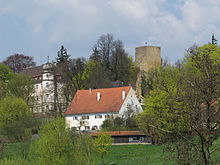Castle House (Neueglofsheim)

Schloss Haus in the Neueglofsheim district of Thalmassing in the Regensburg district in the Upper Palatinate is a small castle complex in a 6-hectare park (Neueglofsheim 1). The facility is a listed building .
history
The former hilltop castle with adjoining Neueglofsheim Castle, built by the Eglofsheimers, was first mentioned in 1314. At that time, the trend towards building noble residential castles, which began in the 11th century, was followed. Of this medieval structure, only the 22.5 meter high keep still exists today . It stands on a 20 by 30 meter plinth, which is separated from the moat by a medieval, three meter high wall. These still visible foundations of the castle today form the north-eastern boundary of the castle complex.
In the period between the 14th and 17th centuries, the castle's owners changed frequently. The owners after the Eglofsheimers were Albrecht Notthracht (1366), Wilhelm von Frauenberg (1388), from 1400 the Nuáberger, the Bavarian dukes (1431), Sigmund Walterhofer (1478) and then the Lords of Wallbrunn . In 1630 the castle was sold to the Regensburg monastery Prüll (Karthaus-Prüll). After the castle was badly damaged in the course of the Thirty Years War , the complex was expanded as a summer residence for the monks as part of the reconstruction in 1681. During this time, the palace chapel was built as the central building for the Carthusians . Today's castle building shows a series of arches on the ground floor, which probably served as a cloister to access the surrounding buildings and rooms.
Probably from 1730 the construction of the actual castle took place in its present size and shape with residential buildings and stables. In the area of today's sacristy, a fountain with horse troughs was probably built at this time. After secularization in 1803, the castle was sold to the Counts of Dörnberg , who sold it on to Thurn und Taxis in 1835 .
Todays use
In the 20th century the castle became the residence of Hereditary Prince Franz Joseph von Thurn und Taxis , who used it as a hunting lodge. After Franz Joseph married Elisabeth von Braganza in 1920, the couple lived and ran Schloss Haus as an agricultural property. In 1928 the south-west wing was increased by two storeys and the palace was completely modernized. Extensive forests with their own forestry were attached to the farm. A brewery and a distillery complemented the activities. At its peak, around 250 people lived and worked in Schloss Haus. The couple spent most of the winters in St. Emmeram Castle . On April 11, 1947, Countess D'Orsay died in Schloss Haus Theresia Grimaud.
Since the death of Franz Joseph von Thurn und Taxis in 1971, the palace complex has not been used and has stood empty. In 1986 it was entered in the list of monuments. In 2008 the Thurn und Taxis sold the castle. The new owners, the Weitzel family, carried out extensive renovations and modernizations, which were recognized in 2009 by the Regensburg district's monument protection award.
Castle house today
The castle is surrounded by a number of buildings such as B. a manor, a machine shop, a mill, a former guest house, a farm workers house and a summer cellar . Together these buildings form the town of Neueglofsheim and administratively belong to the municipality of Thalmassing.
The castle itself is a 4-wing complex around a 700 m² courtyard. The actual part of the castle is a four-story building with an impressive facade and closes the courtyard to the south-west. Connected is the north-west wing, which, in addition to the castle chapel, also contains the supply and kitchen wing. The north-east wing is the so-called " cavalier building ", on the lower floor of which the stables for riding horses were previously housed. The courtyard in the south-east is closed by a so-called "battlement" which connects the cavalier building and the castle. The buildings are only partially basement. Further cellars and connections between the buildings, also outside the direct castle complex, are suspected.
The castle has a 6 hectare park with typical regional, mostly very old trees, meadows, small paths, a nursery with an apiary and the so-called "summer cellar". The summer cellar is a house-like building with an ice cellar 11 m deep below . The ice cellar is designed as a 10 × 40 meter barrel vault and was previously used to store ice blocks. The ice blocks were cut from lakes in winter and used for the brewing process until next autumn.
In the vicinity of the castle there is a Saint Wolfgang oak with a chest height of 9.70 m (2013).
literature
- Andreas Boos : Castles in the south of the Upper Palatinate - the early and high medieval fortifications of the Regensburg area . Universitätsverlag Regensburg, Regensburg 1998, ISBN 3-930480-03-4 , pp. 379-383.
Individual evidence
- ^ List of monuments by Thalmassing .
- ↑ Theresia Grimaud COUNTESS D'ORSAY
- ↑ Mittelbayerische Zeitung of October 21, 2010.
- ^ Entry in the directory of monumental oaks . Retrieved January 10, 2017
Web links
- Schloss Haus on Burgseite.de
- Entry on Neueglofsheim in the private database "Alle Burgen".
- Where the Hereditary Prince once blew Halali on the Mittelbayerische Zeitung of October 12, 2010
- History of Alteglofsheim
Coordinates: 48 ° 54 '9 " N , 12 ° 10' 46.9" E

